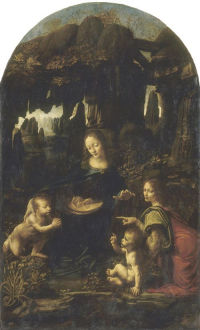Light and Vision Click on the thumbnails to explore the trail
Read more about this trail (expand)
According to Leonardo, the most important of the five senses was sight, the eye being the “window of the soul”. Leonardo thought a great deal about how the eye functioned and how we experience the world in terms of light and shade. His studies of the effects of light on form provided the basis for a revolution in the way that light, colour and space were described in painting.

- Enlarge
- Zoom & explore
- Photo RMN - © René-Gabriel Ojéda
Virgin of the Rocks 1483-c1490
Leonardo’s profound understanding of the relationship between light and colour is clearly illustrated in his paintings.
Traditionally, artists indicated the most brightly lit areas of a painting by lightening their colours with the addition of white pigment. But according to Leonardo, because light revealed the true quality of colour, the areas most brightly lit should contain the purest colour. He advised the artist to observe how colours best appear in nature. Black possesses great beauty in shadow and white in light. Blue and green appear best in middle shadow, yellow and red in light and gold in reflected light.
In this painting, colours loom out of the shadows in varying intensities. Areas of greatest illumination, such as the folds of the Virgin’s blue gown and the angel’s red cloak, are indicated by saturated colours. Reflected light illuminates the golden lining of the Virgins robe. The dull greens and blues of the vegetation provide a pleasing ‘middle shadow’ against which the more illuminated figures stand out. The deeper recesses of the cave dissolve into black shadow, while beyond in the distant landscape the hazy atmosphere glows white.
In Leonardo's words
Since we see that the quality of colour is revealed by means of light, it is to be deduced that where there is more light will be seen more of the true quality of the illuminated colour; and where there is more shadow the colour will be tinged with this shadow. Hence, painter, remember to display the true qualities of colours in the illuminated parts.
This painting was commissioned in 1483 by the Milanese Confraternity of the Immaculate Conception for their large sculpted altarpiece in their chapel of San Francesco Grande, Milan. It was one of a series of painted and sculpted components of a large altarpiece, which included two paintings of music-making angels, now in the National Gallery, London, reliefs portraying episodes from the life of Mary, sculptures of prophets and a large wooden sculpture of the Virgin.
According to the documents, Leonardo was assisted by the brothers Evangelista and Giovanni da Predis in the execution of the altarpiece. A protracted and complex dispute ensued in 1483 regarding payment, which was not resolved until 1508 with the placement of a second version of this painting, now in the National Gallery, London, in the altarpiece.
The execution of a second version of the painting implies that during the years following its completion, the Louvre version must have been either taken, given away or sold. It is possible that it was sold to a third party, possibly Ludovico Sforza.
- Medium Oil on wood panel (transferred to canvas in 1806)
- Size 197 x 120 cm
- Location Musée du Louvre











